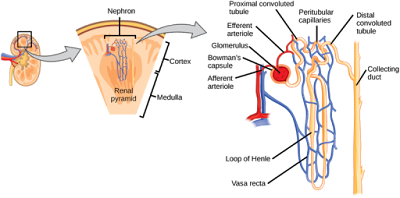Thyroid hormones-formation and secretion
Thyroid mainly secretes two major hormones T3 and T4, also called as throxine and triiodothyronine respectively.Both of these hormones increase metabolic rate of the body. Thyroid secretion of these two hormones is mainly controlled by thyroid stimulating hormone(TSH), which is secreted by anterior pituitary gland.
Formation of thyroid hormones
About 50 milligrams of ingested iodine in the form of iodide is required for the formation of thyroxine. Iodides from the diet are absorbed into the blood from GIT tract and from their are selectively remove by the cells of thyroid gland for the formation of thyroid hormones.
The following steps explain the synthesis of thyroid hormones:
The following steps explain the synthesis of thyroid hormones:
Iodide pump
- The transport of iodides from blood into thyroid cells or follicles is accomplished by the basal membrane of thyroid cells, which has the ability to transport iodides to interior of cell,through active transport.
- The sodium-iodide symporter, which co-transport one iodide along with two sodium ions through plasma membrane to the interior of cell
- Sodium potassium ATPase pump provides energy for the transport of iodide against concentration gradient, and also establish the low intracellular sodium concentration and gradient for facilitated diffusion of sodium into the cell by pumping sodium out of the cell.
- This overall process of concentrating the iodide in the cell is called iodide trapping, which is influenced by several factors one of which is.the concentration of TSH.
- Chloride iodide ion counter transport molecule called pendrin, helps in the transportation of iodide through the thyroid cell across the apical membrane into the thyroid follicles
Oxidation of iodide ion
- After iodide trapping into the thyroid cells,the thyroid ions are converted to an oxidized form of iodine either nascent or I3,the purpose of this step is to make the iodide ion capable of combining directly with the amino acid tyrosine.
- Amino acid tyrosine (Each molecule of thyroglobulin, a glycoprotein molecule secreted by thyroid epithelial cells into follicles,contain about 70 tyrosine amino acids and they are the major substrates that combine with the iodine to form thyroid hormones)
- Enzyme peroxidase promote the oxidation of iodine,which is attached to the apical membrane of the cell,thus providing the oxidized iodine at exactly the point where thyroglobulin molecule,after synthesis comes out from the golgi apparartus and through the cell membrane into stored thyroid cell colloid.
Organification of thyroglobulin
- The binding of iodine with the thyroglobulin is called the organification of thyroglobulin.
- The oxidised iodine will bind directly to the tyrosine of thyroglobulin to form thyroid hormones,first tyrosine is iodized to monoiodotyrosine, and then to triiodotyrosine.
- Then in few days more and more iodotyrosine coupled with one another
- when two molecules of diiodothyronine are joined together, the major hormonal product thyroxine is formed

Secretion of thyroid hormones from thyroid gland
- First, the thyroxine and triiodothronine is cleaved from thyroglobulin and then release from the gland
- This cleavage is accomplished when the apical surface of thyroid cells sends out pseudupod extensions that close around small portion of colloids to form pinolytic vesicles.
- Then lysosomes in the cell cytoplasm fuse with these vesicles to form digestive vesicles which contain digestive enzymes from lysosomes mixed with colloid.
- Multiple proteases digest the thyroglobulin and release thyroxine and teriiodothyronine in free form
- In this way thyroid hormones released into the blood.









